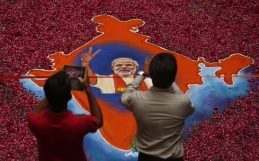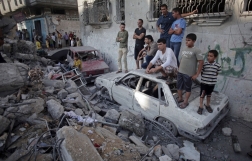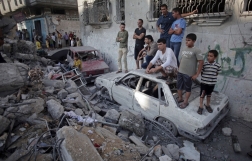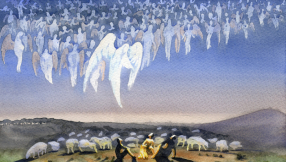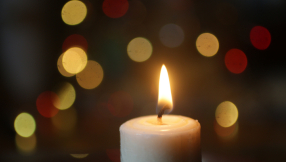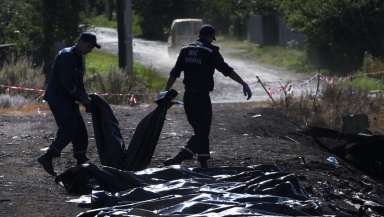
"I have supped full with horrors," remarked Macbeth. "Direness, familiar to my slaughterous thoughts/ Cannot once start me."
We know how he feels. The Israeli assault on Gaza has provided us with images of death and grief beyond imagining. It is easier to switch off the television than to watch, but that is only part of the problem: the pictures are proverbially better on the radio, after all.
There are pictures and stories, too, from the crash site of flight MH17. We have been spared, in the mainstream media at least, close-up images of body parts and corpses, but the pathetic debris of lives cut short – the toys, magazines, suitcases – speaks for itself.
We ought to be horrified by all this, and of course we are. However: it takes a lot more to horrify us today. The ground is shifting; the blizzard of words and images is making us lose our moral bearings.
One reporter who found this was Sky News' Colin Brazier. Overwhelmed by his experience of reporting live from the crash site in Ukraine, in his own words he "crossed a line" and started to rifle through a child's suitcase on air. He apologised immediately; not quickly enough, of course, to defend himself from the ensuing Twitterstorm of abuse.
What's interesting, though, is that he says many other journalists were doing the same – and the trouble is that the "line" he crossed is always receding. What it would have been unthinkable to show 20 years ago is now common journalistic currency.
The BBC holds itself to account using these editorial guidelines. Under the heading "Tragic events", it says: "We should keep our output under review to identify anything that, in the light of events, might cause unjustifiable offence as judged against generally accepted standards." But it's these "generally accepted standards" which are the issue. Not just in news coverage but in TV drama and comedy, words and images which would once have been untransmittable for their violent or sexual references are now broadcast freely, even before the 9 pm "watershed".
So, have the "generally accepted standards" shifted? Of course they have. It takes more to shock us today than it used to. We are simply more used to these images. So for reasons both dishonourable and honourable – the comedian looking for a cheap laugh, the brave journalist wanting to open our eyes to things we'd rather not think about – what we see and hear is more and more graphic and in ever higher definition.
Another line from the BBC's guidelines: "When real life violence, or its aftermath, is shown on television or reported on radio and online we need to strike a balance between the demands of accuracy and the dangers of desensitisation or unjustified distress. There are very few circumstances in which it is justified to broadcast the moment of death."
The BBC, like other news organisations, is aware of the dangers of "desensitisation". However, it's impossible to deny that it's happening.
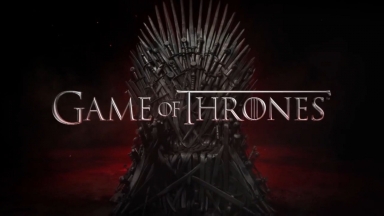
So, what should we do? One response is to resist it. Bible teacher John Piper, for instance, is never shy of controversy. He recently warned his followers against watching the mega-hit fantasy series "Game of Thrones" because of its graphic sexual content. It may be mainstream, highly-respected drama, but there are things that Christians shouldn't watch, and that's one of them, he says. So is there also a case for saying that the camera should not be portraying the extremities of grief experienced by the bereaved families of Gaza, whether they have given their permission to be filmed or not? Is there a point at which other people's emotional distress becomes entertainment – macabre, gruesome, but entertainment nonetheless? We need to know it – but do we need to see it?
Another response is to embrace it. After all, these images are broadcast in a worthy cause. It's only when we know how people are suffering that we are stirred up to do something about it – whether it's going on a march, signing a petition or changing the way we vote. If a picture or a story changes things for good, why should we worry if that line of taste and decency is receding over the horizon? If we don't play the media game, we don't get the results.
There is a Christian third way, though. I don't believe, with all due respect to John Piper, that we can live in a morally aseptic bubble. We have to deal with the unhealthier aspects of our psyche, which include the temptation to voyeurism of various kinds – of sex, of violence, of emotion. But neither do I believe that we should just go along with the "generally accepted standards" of what's acceptable viewing or listening. Christians should be willing to critique change, to be drags on what others see as progress, more willing to complain, to switch off. Some things we don't need to see.
Most of all, we can bring our own reactions, feelings and prejudices before God. How do the pictures of the MH17 crash site make us feel? If they fill us with compassion for the dead and bereaved, good; we should pray. If they make us thirst for vengeance against Vladimir Putin, we should pause: images are immensely powerful, but images are not analysis. How do the images from Gaza make us feel? If they fill us with sorrow and righteous indignation, and make us long for peace, good: if they make us hate, we should repent.
Rev Mark Woods is a freelance writer and Baptist minister.










